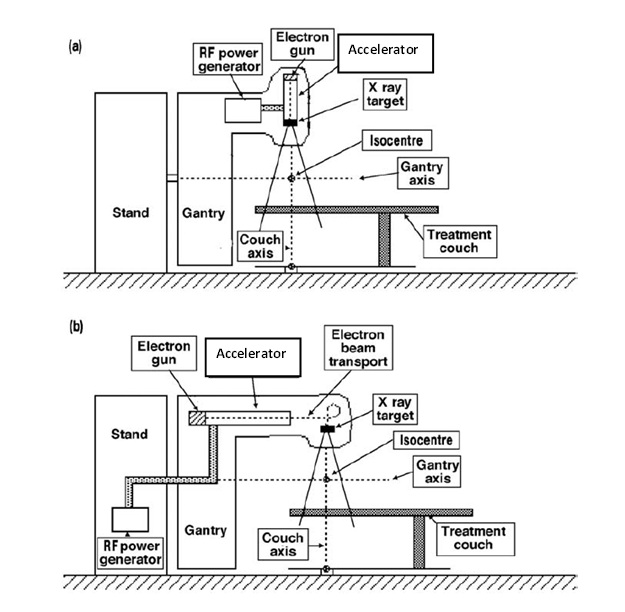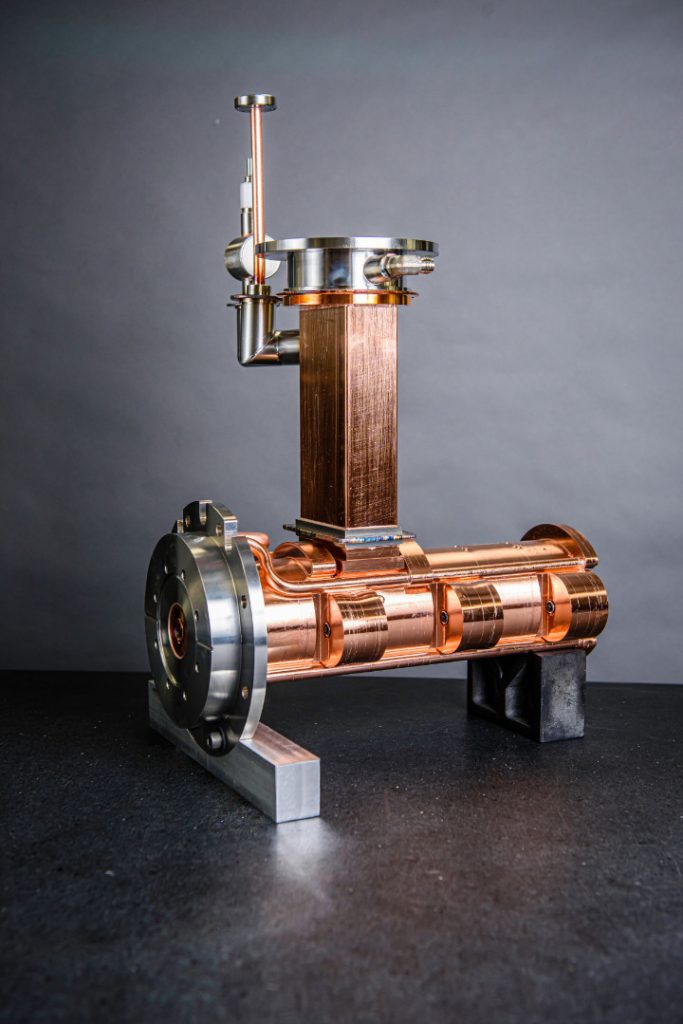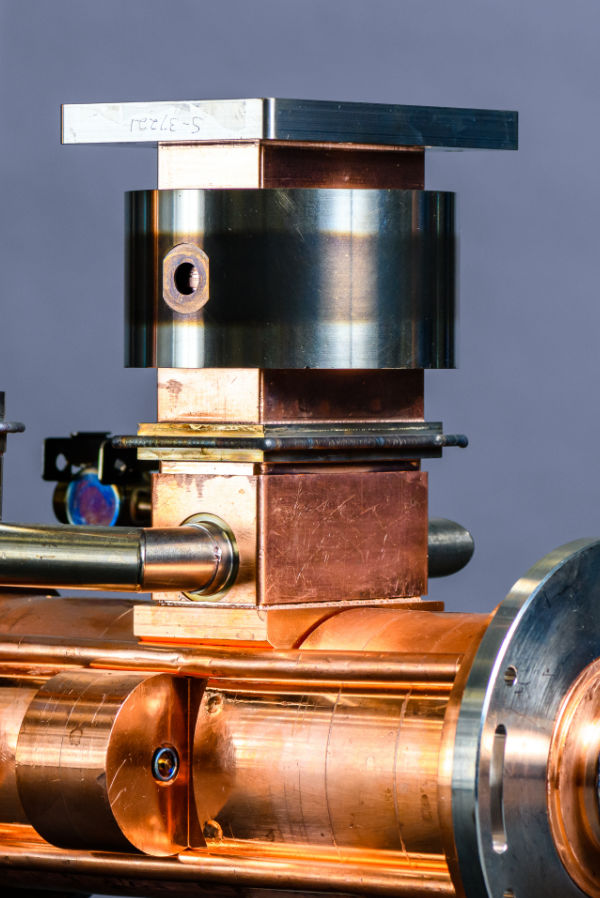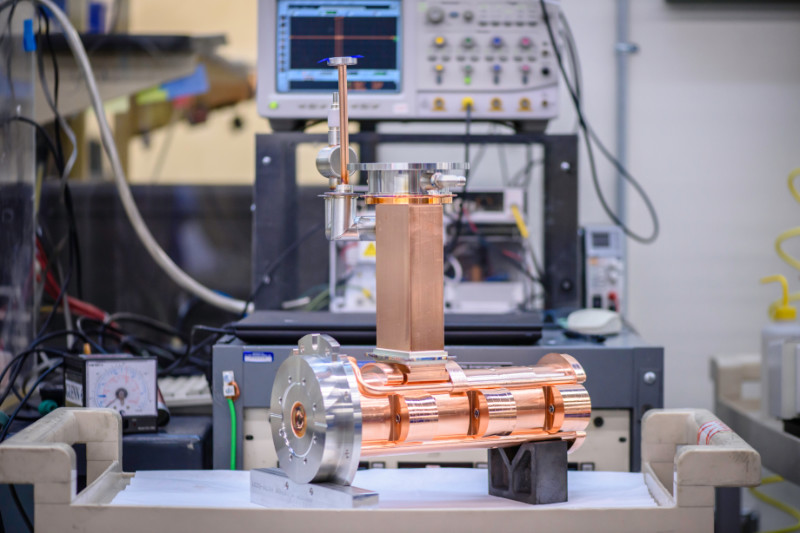
A high energy linear accelerator (LINAC) is an RF powered system inside a radiotherapy machine (RT) that generates ionizing radiation for treatments to kill cancerous cells in oncology treatment centers for radiation therapy (See Figure A & B below). Medical linear accelerators can produce both high energy electron beams or X-Rays (photon beams), range in power from 4 to 25 MeV, can be configured vertically for lower energies, and horizontally for high energy systems that require a beam transport system.
It has the capability to ionize atoms and molecules inside the nuclei of the biological cells of the tissue to which the radiation is applied, thus killing the cancerous cells by damaging their DNA.
In radiotherapy, the majority of radiation treatments use X-rays (photon beams) and a smaller number uses the electron beam or a combination of both therapies. Electron beams are specifically used for superficial tumors (less than 5 cm deep). For this reason, many of the LINAC-based RT machines provide the option of using photon beams as well as electron beams for cancer treatments.
The Medical Linear Accelerator
By: Samy Hanna, PhD, PE – Consultant
Radiation therapy or radiotherapy (RT) describes the clinical process that uses ionizing radiation treatments to kill cancerous cells. It is one of the major medical modalities used in treating cancer. Other widely used cancer-treating modalities are surgery and chemotherapy. Actually, more than half of all cancer patients receive radiotherapy (doses of radiation), either alone or in combination with surgery or chemotherapy. The power of the radiation therapy is its ability to ionize atoms and molecules inside the nuclei of the biological cells of the tissue to which the radiation is applied, thus killing the cancerous cells by damaging their DNA.
The RT machine uses a high energy linear accelerator (LINAC) as the source of the ionizing radiations which can be high energy electron beams, or X-rays (photon beams of an X-Ray linear accelerator). In radiation therapy, the majority of radiation treatments use X-rays and a smaller number uses the electron beam or a combination of both therapies. Electron beams are specially used for superficial tumors (less than 5 cm deep). For this reason, many of the LINAC-based RT machines provide the option of using photon beams as well as electron beams for cancer treatments. In the X-ray therapy, they can produce photon beams in the range of: 4 to 25 MeV, and in the electron therapy, the treatment electron beam can cover the range of 6 to 25 MeV. The length of the LINAC depends on the final electron kinetic energy and ranges from ~30 cm for 4 to 6 MeV LINACs to ~150 cm for the 25-MeV LINACs.
There are two basic configurations for the RT linac machine. In one configuration, shown in Figure 1 (a), the LINAC is mounted in the machine’s gantry perpendicular to the patient. This is the simplest configuration for a radiation linear accelerator for a cancer machine (commonly called a medical linear accelerator). It eliminates the need for an intricate beam transport system.

This is typically used in photon therapy for treatment photon energies between 4 and 6 MeV. On the other hand, in higher energy machines, the LINACs, which are longer, are located in the machine’s gantry parallel to the gantry axis of rotation, as shown in Figure 1(b). For external beam radiation, an intricate beam transport system is then used to transport the electron beam from the accelerator to the treatment head. This configuration is usually used in RT machines delivering both X-ray or electron beams and at multiple energies up to 25 MeV. Contact one of our specialists today for a quick feasibility study of your project.
[1] S. Hanna. “RF Linear Accelerators for Medical and Industrial Applications”, Artech House Publishing, 2012.
[2] Podgorsak, E. B. (ed.), Radiation Oncology Physics: A Handbook for Teachers and Students, Vienna: International Atomic Energy Agency (IAEA), 2005.







